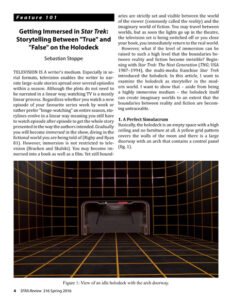
Sebastian Stoppe
Getting Immersed in Star Trek
Storytelling Between “True” and “False” on the Holodeck
Television is a writer’s medium. Especially in serial formats, television enables the writer to narrate large-scale stories spread over several episodes within a season. Although the plots do not need to be narrated in a linear way, watching TV is a mostly linear process. Regardless whether you watch a new episode of your favourite series week by week or rather prefer “binge-watching” an entire season, storylines evolve in a linear way meaning you still have to watch episode after episode to get the whole story presented in the way the authors intended. Gradually you will become immersed in the show, diving in the fictional world you are being told of. However, immersion is not restricted to television. You may become immersed into a book as well as a film. Yet still boundaries are strictly set and visible between the world of the viewer (commonly called the reality) and the imaginary world of fiction. You may travel between worlds, but as soon the lights go up in the theatre, the television set is being switched off or you close your book, you immediately return to the real world.
However, what if the level of immersion can be raised to such a high level that the boundaries between reality and fiction become invisible? Beginning with Star Trek: The Next Generation (USA 1987–1994), the multi-media franchise Star Trek introduced the holodeck. In this article, I want to examine the holodeck as storyteller in the modern world. I want to show that – aside from being a highly immersive medium – the holodeck itself can create imaginary worlds to an extent that the boundaries between reality and fiction are becoming untraceable.
| Journal Website ISSN 1068-395X |
|
lock_open_right Full Text [media/rep/] lock_open_right Full Text [zenodo] |
| Suggested Citation Stoppe, Sebastian (2016): Getting Immersed in Star Trek, Storytelling Between “True” and “False” on the Holodeck, in: SFRA Review 316, pp. 4-15 DOI 10.25969/mediarep/16799 [media/rep/ version only] 10.5281/zenodo.8326649 [zenodo version only] |